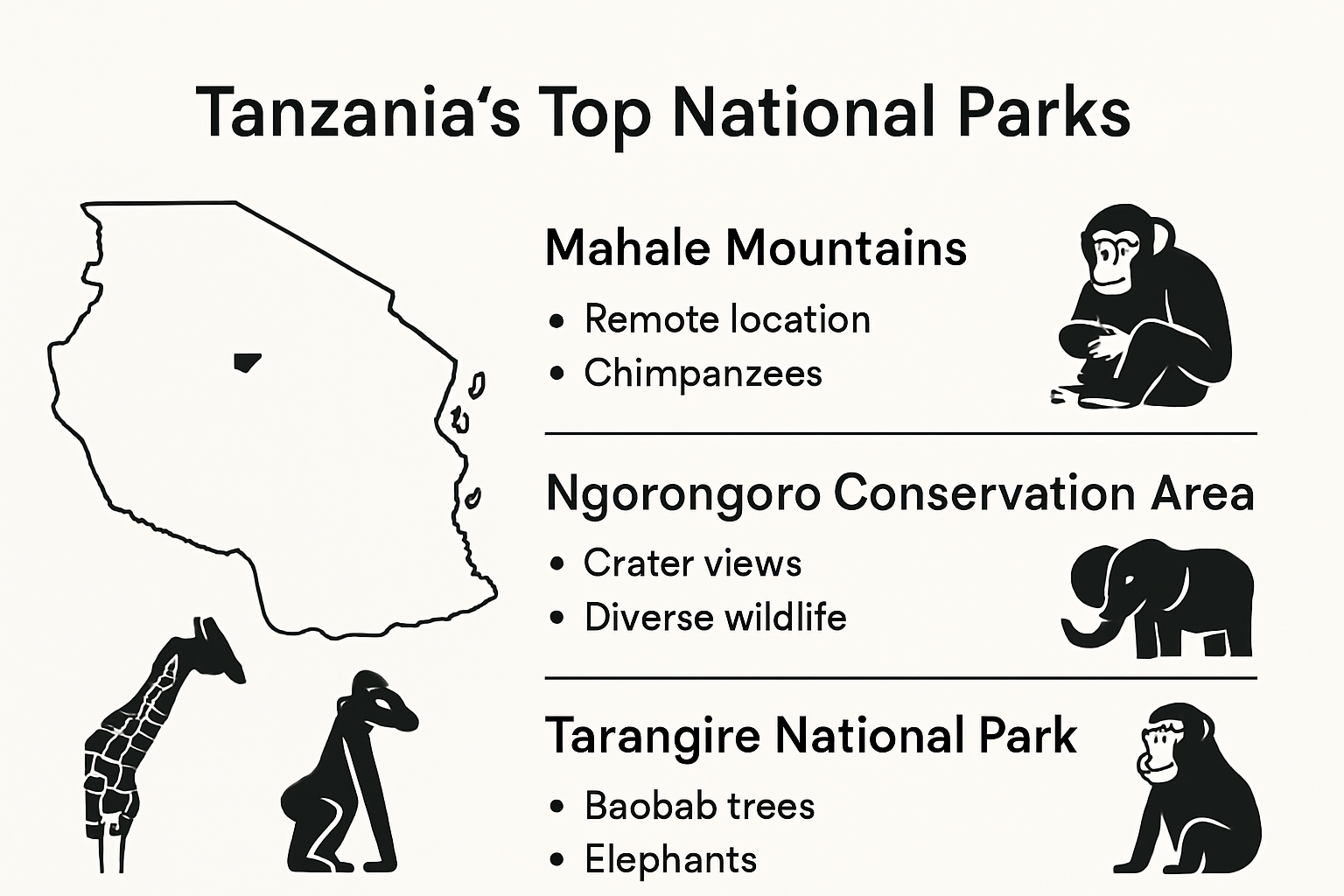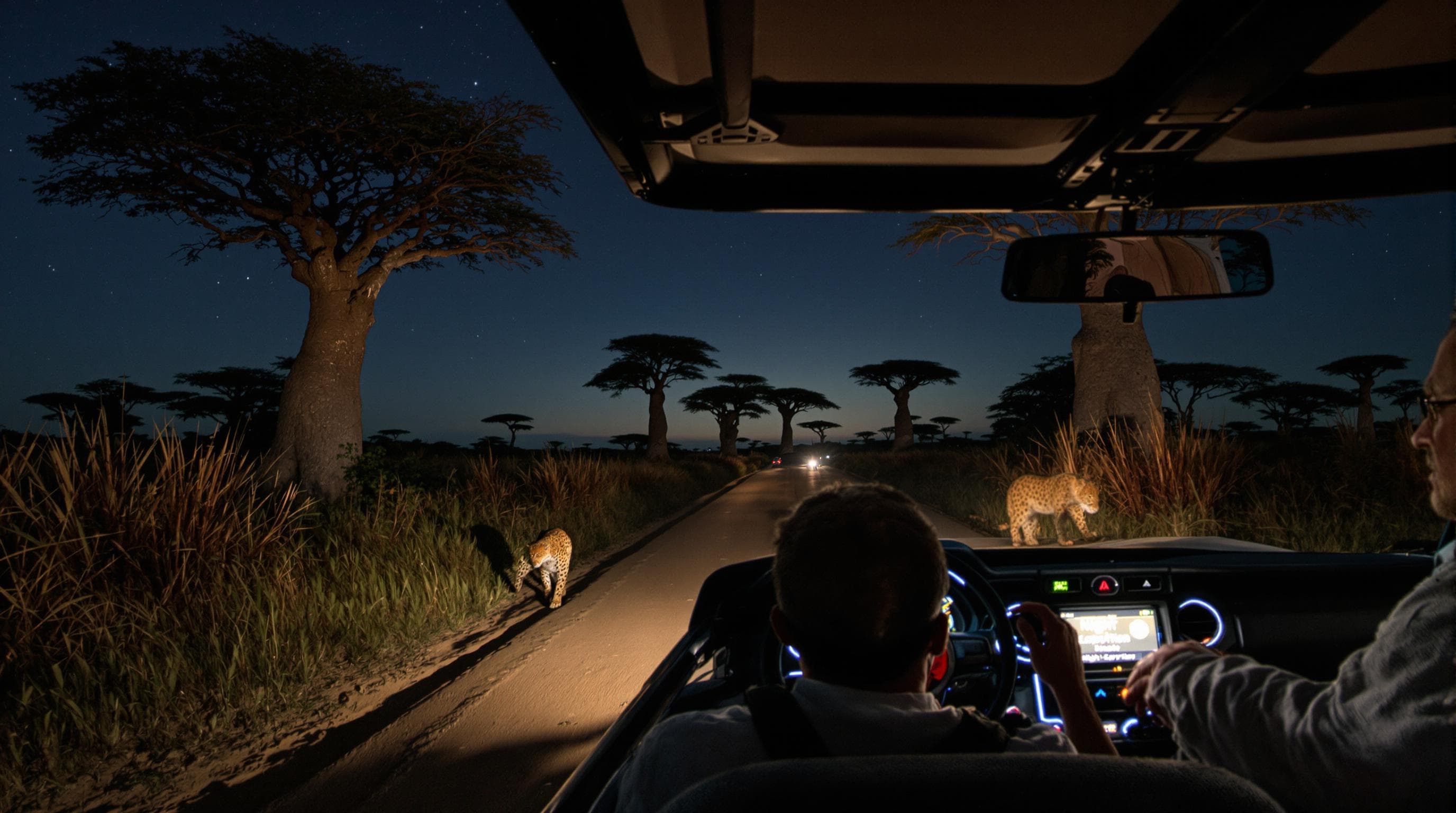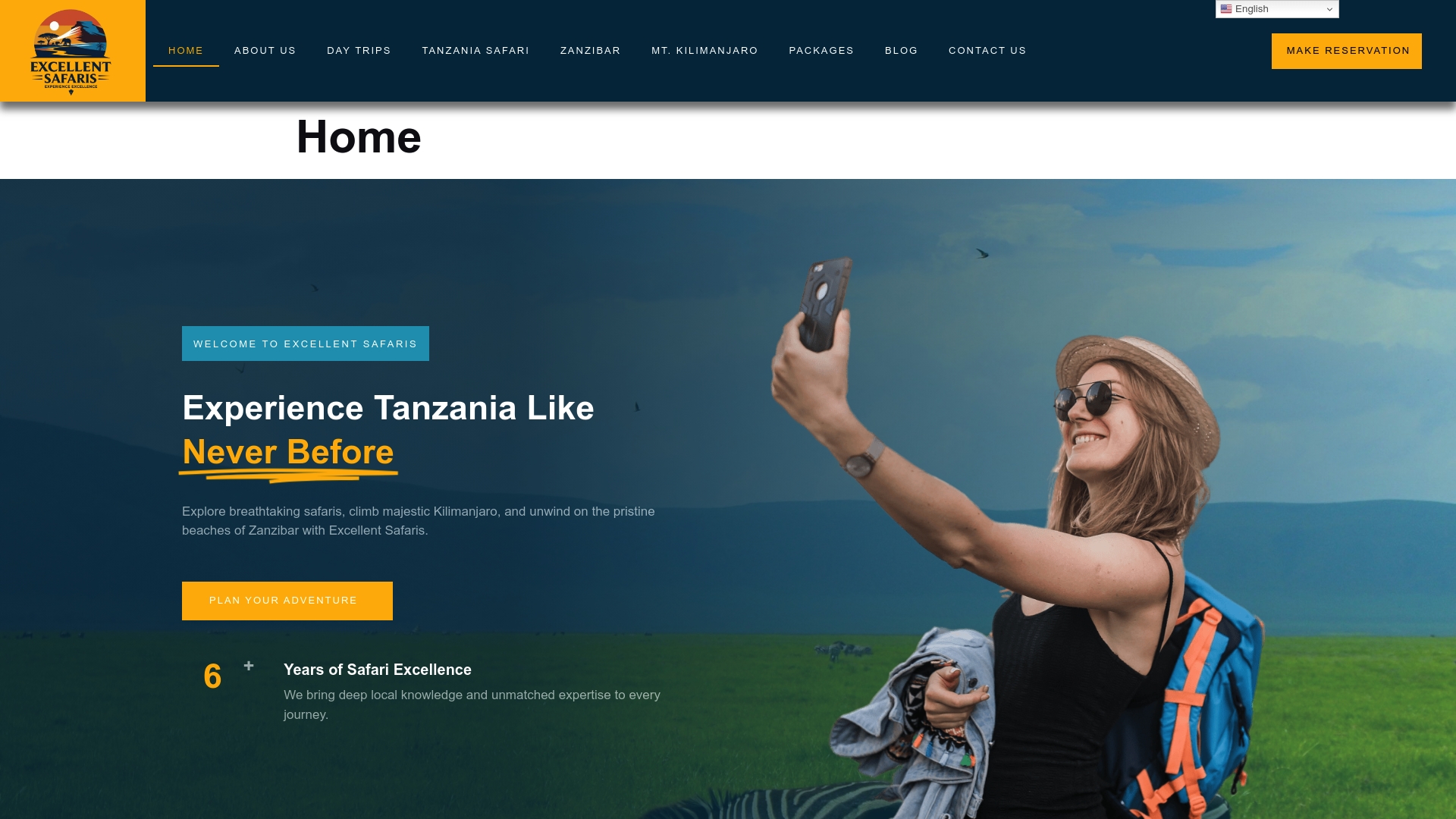Tanzania has some of the richest wildlife experiences on the planet. One park alone, Ngorongoro, packs about 25,000 large animals into a single volcanic crater. Sounds like you’ll be surrounded by a noisy herd at every turn, right? Not quite. Some of the most mind-blowing moments actually happen far from the crowds in hidden sanctuaries and remote forests, proving that the country’s best safari treasures are much wilder and more unexpected than you’d ever guess.
| Takeaway | Explanation |
|---|---|
| Unique Safari Destinations | Tanzania’s national parks, such as Mahale Mountains, Ngorongoro Conservation Area, and Tarangire National Park, offer extraordinary ecosystems and wildlife interactions beyond traditional safaris. |
| Engaging Wildlife Experiences | Opportunities like nocturnal wildlife expeditions, interactive conservation tracking, and cultural wildlife interactions enrich the safari experience, allowing intimate connections with wildlife and local communities. |
| Cultural Immersion & Responsible Travel | Engaging with indigenous communities like the Hadzabe and Maasai enhances the travel experience while promoting conservation and supporting local development initiatives. |
| Luxury and Personalized Planning | Selecting the right time and less frequented parks, along with choosing sustainable luxury accommodations, allows travelers to enjoy bespoke safari experiences that blend comfort with authentic wildlife encounters. |
Tanzania offers wildlife enthusiasts an extraordinary collection of national parks that transcend typical safari experiences. These destinations provide more than standard wildlife viewing opportunities they immerse travelers in remarkable ecosystems with extraordinary biodiversity and stunning landscapes.

Mahale Mountains National Park represents a truly exceptional safari destination for wildlife lovers seeking rare primate interactions. Located on the eastern shore of Lake Tanganyika, this park harbors one of the largest populations of eastern chimpanzees in the world. Research from the World Wildlife Fund indicates that Mahale provides an unparalleled opportunity to observe these intelligent primates in their natural habitat.
Unlike traditional savanna parks, Mahale offers a unique landscape where dense tropical forests meet crystal clear lake waters. Visitors can experience intimate chimpanzee tracking experiences, watching these remarkable creatures engage in complex social behaviors just meters away. The park’s remote location ensures minimal human interference, creating an authentic wilderness experience that goes beyond standard wildlife viewing.
The Ngorongoro Conservation Area stands as a geological marvel that redefines safari expectations. Scientific studies published in Nature highlight the crater as a self-contained ecosystem supporting an extraordinary concentration of wildlife within a collapsed volcanic caldera. This UNESCO World Heritage site offers visitors a chance to witness the intricate balance of predator and prey in a uniquely confined environment.
What makes Ngorongoro truly special is its integrated approach to conservation, blending wildlife protection with traditional Maasai pastoral practices. The crater floor hosts approximately 25,000 large animals, including rare black rhinoceros, providing photographers and wildlife enthusiasts an unparalleled opportunity to capture diverse species in a single, breathtaking landscape.
Tarangire National Park offers a distinctive safari experience characterized by massive elephant herds and iconic baobab trees. Conservation research from African Wildlife Foundation reveals that this park hosts one of the largest elephant populations in northern Tanzania, with herds sometimes numbering over 300 individuals.
Beyond elephants, Tarangire presents a less crowded alternative to more famous parks, allowing for more intimate wildlife interactions. The park’s unique ecosystem transitions between grasslands and acacia woodlands, creating diverse habitats that support an impressive array of wildlife. During dry seasons, the Tarangire River becomes a critical water source, attracting numerous species and offering exceptional game viewing opportunities.
These national parks demonstrate Tanzania’s commitment to preserving extraordinary wildlife habitats. Each destination offers a unique narrative of conservation, biodiversity, and natural wonder, inviting travelers to experience safari adventures that go far beyond traditional expectations. Learn more about our curated safari experiences.
Tanzania’s national parks offer travelers an extraordinary range of wildlife experiences that go far beyond traditional safari expectations. These immersive encounters provide intimate connections with some of the world’s most remarkable animal ecosystems, creating memories that transform ordinary travel into extraordinary adventures.
Night game drives represent a thrilling dimension of wildlife exploration in Tanzania’s national parks. According to the Tanzania National Parks Authority, select parks provide exclusive night safari experiences that reveal a completely different world of animal behavior. During these nocturnal expeditions, visitors can observe elusive predators like leopards, genets, and smaller carnivores that remain hidden during daylight hours.
Specialized night vision equipment and expert guides enhance these experiences, allowing travelers to witness hunting behaviors, territorial markings, and interactions rarely seen during conventional daytime safaris. The darkness transforms the landscape, creating an atmosphere of mystery and anticipation where every rustle and sound becomes a potential wildlife encounter.

Modern safari experiences in Tanzania have evolved to provide deeply engaging conservation-focused activities. Research from the Burunge Wildlife Management Area demonstrates how wildlife tourism now integrates visitor participation with ecological preservation. Travelers can join professional researchers and park rangers in tracking endangered species, monitoring animal populations, and understanding complex ecosystem dynamics.
These interactive experiences might include following chimpanzee troops in Mahale Mountains, participating in rhino conservation efforts in Ngorongoro, or assisting with elephant behavior studies in Tarangire. Such activities not only provide extraordinary wildlife encounters but also contribute directly to scientific research and conservation efforts. Visitors gain profound insights into animal behaviors, ecological challenges, and the intricate balance of wilderness ecosystems.
Tanzania’s national parks offer unique opportunities to understand wildlife through the lens of indigenous knowledge. Anthropological studies published in Conservation Biology highlight how local communities possess deep, generational understanding of wildlife behaviors and ecosystems. Many safari experiences now incorporate traditional Maasai or Hadzabe insights, allowing travelers to learn tracking skills, understand animal migration patterns, and appreciate wildlife from cultural perspectives.
These cultural wildlife interactions transform standard safari experiences into immersive journeys of understanding. Visitors can learn traditional tracking techniques, participate in storytelling sessions about local wildlife mythology, and gain insights into how human communities have coexisted with wildlife for generations. Such experiences provide context beyond mere animal observation, creating deeper, more meaningful connections with Tanzania’s remarkable natural world.
By offering diverse, interactive, and scientifically informed wildlife experiences, Tanzania’s national parks redefine safari tourism. Explore our curated wildlife adventure packages to discover experiences that blend conservation, cultural understanding, and extraordinary animal encounters.
Tanzania’s national parks offer more than wildlife encounters they provide profound opportunities for cultural immersion and responsible travel that respect local communities and ecological sustainability. These experiences transform traditional tourism into meaningful exchanges that benefit both travelers and indigenous populations.
The Hadzabe and Maasai communities represent extraordinary cultural encounters within Tanzania’s national parks. Research from Responsible Travel reveals that in 2011, the Tanzanian government granted land titles to the Hadzabe people, enabling them to manage tourism activities and preserve their traditional lifestyle. These interactions allow travelers to experience hunter-gatherer traditions that have remained virtually unchanged for thousands of years.
Visitors can participate in traditional hunting techniques, learn about medicinal plant uses, and understand complex social structures that have sustained these communities for generations. Such experiences go beyond simple observation, creating genuine cross-cultural understanding and mutual respect. The Maasai, known for their distinctive clothing and pastoral traditions, offer similar immersive experiences that provide insights into their intricate relationship with the landscape and wildlife.
Anthropological studies in the Ngorongoro Conservation Area demonstrate a unique model of human-wildlife coexistence. This UNESCO World Heritage site integrates wildlife protection with traditional Maasai pastoral practices, showing how cultural preservation and ecological conservation can work symbiotically. Tourism revenues directly support local infrastructure, including schools, medical facilities, and community development projects.
Below is a table summarizing the key models of cultural and wildlife integration described in this section:
| Initiative/Area | Key Features | Community Benefit | Wildlife Benefit |
|---|---|---|---|
| Hadzabe Land Title (2011) | Indigenous management of tourism and land | Preserves culture & provides income | Sustains traditional land stewardship |
| Maasai Pastoral Practices | Integrated into conservation areas (e.g., Ngorongoro) | Supports pastoral livelihoods | Models co-existence, preserves grazing land |
| Community Development Projects | Tourism revenue funds schools & clinics | Improves infrastructure and services | Incentivizes conservation |
| Community-Owned Tourism Experiences | Local-run guides/lodges, skill transfer | Local economic empowerment | Reduces poaching pressure |
Research published in Tropical Conservation Science indicates that tourists with strong ecocentric attitudes are more likely to support meaningful conservation efforts. This shift represents a growing trend towards responsible travel that values environmental and cultural preservation over mere entertainment.
Sustainable tourism practices in Tanzania’s national parks include limiting visitor numbers, supporting local conservation initiatives, and ensuring that economic benefits directly reach indigenous communities. Travelers can choose experiences that minimize environmental impact, support local economies, and respect cultural traditions. This might involve staying in community-owned lodges, participating in conservation research, or supporting local artisan cooperatives.
By embracing these principles, travelers transform their safari experience from a simple vacation into a meaningful journey of cultural understanding and ecological responsibility. Discover our responsible travel experiences that connect you deeply with Tanzania’s remarkable landscapes and communities.
Planning a luxury safari in Tanzania requires meticulous attention to detail, strategic timing, and a deep understanding of the unique ecosystems that make these national parks extraordinary destinations. Discerning travelers seek experiences that blend exclusive comfort with authentic wilderness encounters, transforming a standard safari into an extraordinary journey of discovery.
Research from African Safari Experts indicates that the dry season from June to October represents the optimal period for wildlife viewing in Tanzania’s national parks. During these months, animals congregate around limited water sources, creating unparalleled opportunities for wildlife observation. Sophisticated travelers can maximize their experiences by selecting less frequented parks that offer more intimate wildlife encounters.
Parks like Ruaha and Katavi provide exceptional alternatives to more crowded destinations. Explorers Against Extinction highlights these parks as hidden gems, offering untouched wilderness and significant wildlife populations with minimal tourist traffic. By choosing these exclusive locations, luxury travelers can enjoy more personalized experiences and closer wildlife interactions.
Here’s a comparison table highlighting three top Tanzania safari destinations and what makes them unique:
| National Park/Area | Signature Wildlife/Feature | Unique Experience | Crowds |
|---|---|---|---|
| Mahale Mountains | Eastern chimpanzees | Primate tracking, forest meets lake | Very Low |
| Ngorongoro Conservation | 25,000 large animals, black rhino | Caldera ecosystem, Maasai culture | Moderate |
| Tarangire | Massive elephant herds, baobabs | Underrated sanctuary, dry season congregations | Lower than Serengeti |
| Ruaha | Predators, large prides, wild dogs | Remote, untouched, fewer tourists | Very Low |
| Katavi | Buffalo herds, crocodile pods | Largely unexplored, huge animal gatherings | Extremely Low |
Modern luxury safari experiences transcend traditional comfort, integrating sustainable practices with exceptional hospitality. Sustainable Tourism Research emphasizes the importance of selecting lodges that implement eco-friendly practices. These accommodations not only provide supreme comfort but also contribute directly to conservation efforts and local community development.
Top-tier lodges now offer features like solar power, water recycling systems, and locally sourced organic cuisine. Some properties provide exclusive experiences such as private game drives, personalized wildlife photography workshops, and guided interactions with conservation researchers. These experiences transform luxury travel from mere consumption to meaningful engagement with Tanzania’s remarkable ecosystems.
Bespoke safari planning requires a holistic approach that considers individual preferences, physical capabilities, and specific wildlife interests. Advanced travelers can customize their experiences by working with specialized safari consultants who understand the nuanced differences between Tanzania’s national parks. This might include designing photography-focused expeditions, arranging private guided tours with renowned wildlife experts, or creating multi-park itineraries that showcase diverse ecosystems.
Considerations like physical accessibility, photography opportunities, specific wildlife interests, and cultural interactions play crucial roles in crafting the perfect luxury safari. Some travelers might prioritize chimpanzee tracking in Mahale Mountains, while others might seek the vast elephant herds of Tarangire or the unique crater ecosystem of Ngorongoro.
By approaching safari planning as a deeply personalized experience, luxury travelers can create journeys that are not just vacations, but transformative encounters with one of the world’s most extraordinary natural landscapes. Explore our bespoke safari planning services to begin crafting your ultimate Tanzanian adventure.
Tanzania’s top national parks for safari include Mahale Mountains, Ngorongoro Conservation Area, and Tarangire National Park. Each park offers unique ecosystems and wildlife experiences beyond traditional safaris.
Mahale Mountains National Park is ideal for those seeking rare chimpanzee encounters. It boasts a large population of eastern chimpanzees in a beautiful setting where tropical forests meet Lake Tanganyika.
The dry season from June to October is the optimal time for wildlife viewing in Tanzania. During this period, animals congregate around water sources, providing excellent opportunities for observation.
To ensure a responsible safari, choose tours that support local communities and conservation initiatives. Opt for sustainable accommodations and participate in activities that engage with local cultures and wildlife conservation efforts.
Are you searching for a safari that goes far beyond the ordinary, just like the exclusive experiences described in our guide to Tanzania’s national parks? Many people struggle to find wildlife journeys that are not overwhelmed by crowds or limited by cookie-cutter itineraries. You want authentic wildlife encounters in places like Ngorongoro and Tarangire, intimate cultural connections, and the confidence that your travel leaves a positive impact.

With Excellent Safaris, you get more than a checklist of destinations. Discover curated safaris, tailored to your interests, whether you dream of tracking chimpanzees in Mahale, exploring the hidden corners of Tarangire, or creating a sustainable journey that benefits both nature and local communities. Start planning your unique adventure today and see how our expertise shapes every detail. Explore our personalized safari options and transform your 2025 Tanzania travel dreams into reality.
WhatsApp us